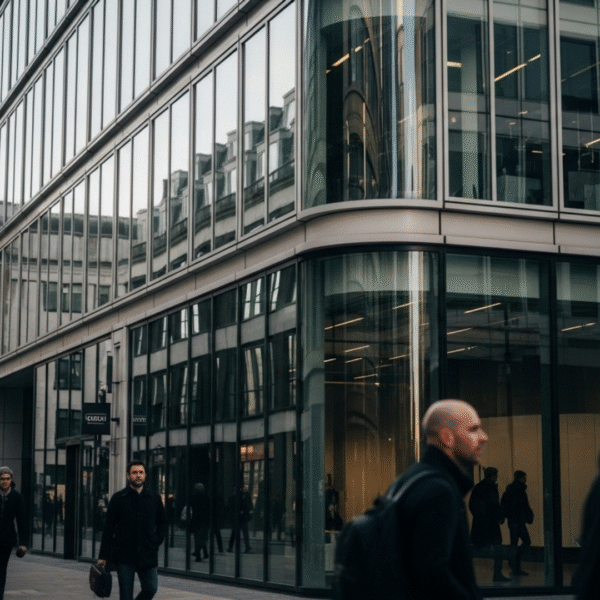Location strategy now decides who wins the talent war. In Kings Cross the right anchor tenant turned a fringe market into a premium district. Get the tenant mix right and you change perception then pricing then performance.
How Google redefined the Kings Cross market?
In 2010 Kings Cross office rents sat 48% below the London city centre average. By 2022 they were 19% above. Centre for Cities reports this shift followed a deliberate anchor strategy that pulled in tech and creative firms and reset expectations about what N1C could offer to employers and talent.
Google delivered the decisive signal. Gardiner and Theobald document a commitment of around 1 million square feet across an 11-storey landscraper with capacity for up to 7,000 employees.
That scale, plus a multi-building campus presence at 6 Pancras Square and a third site, communicated permanence and confidence.
It reduced perceived risk for occupiers and investors, validating the area’s Knowledge Quarter identity. Premium brands followed and paid for certainty instead of taking a chance.
The market moved because anchors are market makers. A global tech leader raised design and sustainability standards, which led developers and landlords to upgrade product quality. Demand deepened across complementary sectors, and rents soon reflected the new positioning rather than the old postcode reputation.
What signals did Google send to the market?
Google’s move wasn’t just a lease; it was a market signal. Every element of its campus reshaped how investors, occupiers, and developers read the area’s potential.

Here’s what those signals looked like in practice:
- Scale and permanence that de-risked occupancy decisions
- Talent density and daily footfall that supported new retail and amenities
- Design leadership that set higher workplace benchmarks
- Validation of a tech and creative hub identity
- Confidence that justified premium rents across N1C
That confidence did not come from floor plates alone, it came from a new standard of workplace quality that others now have to match.
How did workplace quality reset the market?
Google did more than fill floor space in N1C. It rewrote the workplace brief. The 330-metre-long landscraper, a design uniting Heatherwick Studio, Bjarke Ingels Group, and BDP, includes roof terraces, a running track, and a swimming pool.
That amenity mix reframed what a London campus should offer for health, collaboration, and daily experience. It made workplace quality the competitive lever, forcing competitors to fight on quality not just proximity to Zone 1.
The project embedded healthy materials through Google’s sustainability standards, and landlords across the district responded with better ventilation, greener materials, and stronger public realm integration.
The ripple effects were measurable. Centre for Cities shows the number of firms in the area roughly doubled to about 800 between 2010 and 2021, while jobs rose from about 8,000 in 2011 to about 27,000 in 2019.
A tech and creative identity took hold that suited companies competing in tight labour markets. Smart anchors do not just lease space.
They build ecosystems where talent wants to work and where businesses want to locate.
What foundation turned anchors into market makers?
Kings Cross worked because the place worked for people first. Centre for Cities records that about 40% of land was kept as public realm with ten new parks and squares and twenty new streets. Combined with the rebuilt transport hubs at Kings Cross and St Pancras including HS1, this created legible routes, dwell time, and a seamless commute.
Flexibility was the second pillar. A single 2006 permission allowed about 20% leeway in use definitions and locations, so the masterplan could switch as opportunities appeared.
Consolidated ownership through KCCLP and patient capital from BT Pensions and AustralianSuper backed decisions that prioritised place. Central Saint Martins arrived early and injected creative energy that later anchors valued.
The resulting offer signalled a distinct market position that pulled away from City and West End templates.
- Tech, creative and education became the centre of gravity, not traditional finance
- Campus scale paired with cultural neighbours improved daily appeal
- Permeable streets and squares supported retail, events and informal collaboration
- Quality and sustainability standards aligned with employer brand needs
- Student presence delivered ideas, energy and reliable footfall
The pattern is consistent. Transformative anchors need transport capacity, generous public realm, planning adaptability and a coherent identity to multiply their impact. With those ingredients employers can convert location into lower friction commutes and better retention.
Translating the anchor effect into everyday office decisions
This article showed how Google’s commitment in King’s Cross rewired perception, pricing, and performance by pairing scale with workplace quality in a people-first district.
Most companies won’t act at that scale, yet the talent war still hinges on the same signals: commute ease, amenity-rich public realm, sustainability, and design.

ADAPT’s role is to help growth-stage teams send those anchor-grade signals through smarter, flexible space choices.
We decode the foundations that made N1C work-transport capacity, generous public realm, flexible planning and amenity mix, and building quality-then curate a Top 10 that fits your size, culture, and runway.
Our 360° service sources exclusive, off-market options, aligns layouts and branding to how your team collaborates, and builds in flexibility so you can scale from 2 to 100+ without costly resets.
With transparent fixed fees and deep provider relationships, you get premium outcomes without paying for excess or being locked into outdated leases.
In a fragmented flex market that’s expanding fast, ADAPT bridges the credibility gap. Clients hire faster, retain better, and see higher office utilization because their workplace competes on quality-not postcode.
You don’t need a million square feet to change your talent story. Choose the right building in the right ecosystem, then tailor it to how your team actually works-that’s the anchor effect, right-sized.
Chris Meredith, ADAPT CEO & Founder
What can you do to get ahead of the location strategy that wins the talent war?
If you’re competing for talent, opening a hub near major transport, rebalancing your hybrid footprint, or stuck in a legacy lease far from the amenities your people expect-now is the time to act.
Flexible, high-quality space in the right ecosystem doesn’t just work better. It signals better.
ADAPT can not only help you find a smarter, transit-connected, amenity-rich office space (that fits your needs perfectly) but also set you up with the best possible solution for the future.
With our help, your next office could be more than an address. It’s can be signal of where your business is heading. See how at ADAPT.






